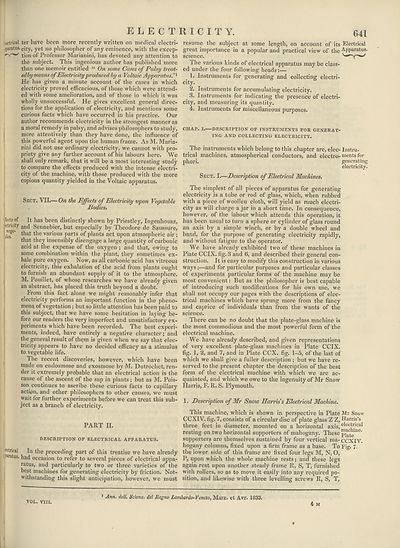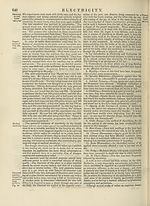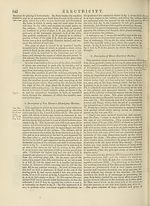Encyclopaedia Britannica > Volume 8, DIA-England
(651) Page 641
Download files
Complete book:
Individual page:
Thumbnail gallery: Grid view | List view

ELECTRICITY
641
ectrical ter have been more recently written on medical electri-
paratus. city, yet no philosopher of any eminence, with the excep-
'"Y"-’' tion of Professor Marianini, has devoted any attention to
the subject. This ingenious author has published more
than one memoir entitled “ On some Cases of Palsy treat-
edby means of Electricity produced by a Voltaic Apparatus.'’1
He has given a minute account of the cases in which
electricity proved efficacious, of those which were attend¬
ed with some amelioration, and of those in which it was
wholly unsuccessful. He gives excellent general direc¬
tions for the application of electricity, and mentions some
curious facts which have occurred in his practice. Our
author recommends electricity in the strongest manner as
a moral remedy in palsy, and advises philosophers to study,
more attentively than they have done, the influence of
this powerful agent upon the human frame. As M. Maria¬
nini did not use ordinary electricity, we cannot with pro¬
priety give any further account of his labours here. We
shall only remark, that it will be a most interesting study
to compare the effects produced with the intense electri¬
city of the machine, with those produced with the more
copious quantity yielded in the Voltaic apparatus.
Sect. VII.— On the Effects of Electricity upon Vegetable
. Bodies.
Teds of It has been distinctly shown by Priestley, Ingenhousz,
■dncity an(] Sennebier, but especially by Theodore de Saussure,
iesf6 ^iat ^ie var’ous parts of plants act upon atmospheric air ;
that they insensibly disengage a large quantity of carbonic
acid at the expense of the oxygen ; and that, owing to
some combination within the plant, they sometimes ex¬
hale pure oxygen. Now, as all carbonic acid has vitreous
electricity, this exhalation of the acid from plants ought
to furnish an abundant supply of it to the atmosphere.
M. Pouillet, of whose researches we have already given
an abstract, has placed this truth beyond a doubt.
brom this fact alone we might reasonably infer that
electricity performs an important function in the pheno¬
mena of vegetation; but so little attention has been paid to
this subject, that we have some hesitation in laying be¬
fore our readers the very imperfect and unsatisfactory ex¬
periments which have been recorded. The best experi¬
ments, indeed, have entirely a negative character; and
the general result of them is given when we say that elec¬
tricity appears to have no decided efficacy as a stimulus
to vegetable life.
Ihe recent discoveries, however, which have been
made on endosmose and exosmose by M. Dutrochet, ren¬
der it extremely probable that an electrical action is the
cause of the ascent of the sap in plants; but as M. Pois¬
son continues to ascribe these curious facts to capillary
action, and other philosophers to other causes, we must
wait for further experiments before we can treat this sub¬
ject as a branch of electricity.
PART II.
DESCRIPTION OF ELECTRICAL APPARATUS.
cctrical In the preceding part of this treatise we have already
t’aratus. ]ia(j occasion to refer to several pieces of electrical appa¬
ratus, and particularly to two or three varieties of the
best machines for generating electricity by friction. Not¬
withstanding this slight anticipation, however, we must
resume the subject at some length, on account of its Electrical
great importance in a popular and practical view of the Apparatus,
science.
Ihe various kinds of electrical apparatus maybe class¬
ed under the four following heads:—■
1. Instruments for generating and collecting electri¬
city.
2. Instruments for accumulating electricity.
3. Instruments for indicating the presence of electri¬
city, and measuring its quantity.
4. Instruments for miscellaneous purposes.
CHAP. I.—DESCRIPTION OF INSTRUMENTS FOR GENERAT¬
ING AND COLLECTING ELECTRICITY.
The instruments which belong to this chapter are, elec- Instru-
trical machines, atmospherical conductors, and electro-ments f°r
phori. generating
electricity.
Sect. I.—Description of Electrical Machines.
The simplest of all pieces of apparatus for generating
electricity is a tube or rod of glass, which, when rubbed
with a piece of woollen cloth, will yield as much electri¬
city as will charge a jar in a short time. In consequence,
however, of the labour which attends this operation, it
has been usual to turn a sphere or cylinder of glass round
an axis by a simple winch, or by a double wheel and
band, for the purpose of generating electricity rapidly,
and without fatigue to the operator.
We have already exhibited two of these machines in
Plate CCIX. fig. 3 and 6, and described their general con¬
struction. It is easy to modify this construction in various
ways;—and for particular purposes and particular classes
of experiments particular forms of the machine may be
most convenient: But as the philosopher is best capable
of introducing such modifications for his own use, we
shall not occupy our pages with the descriptions of elec¬
trical machines which have sprung more from the fancy
and caprice of individuals than from the wants of the
science.
There can be no doubt that the plate-glass machine is
the most commodious and the most powerful form of the
electrical machine.
We have already described, and given representations
of very excellent plate-glass machines in Plate CCIX.
fig. 1, 2, and 7, and in Plate CCX. fig. 1-5, of the last of
which we shall give a fuller description ; but we have re¬
served to the present chapter the description of the best
form of the electrical machine with which we are ac¬
quainted, and which we owe to the ingenuity of Mr Snow
Harris, F. li. S. Plymouth.
1. Description of Mr Snoio Harris's Electrical Machine.
This machine, which is shown in perspective in Plate Mr Snow
CCXIV. fig. 7, consists of a circular disc of plate glass Z Z, Harris’s
three feet in diameter, mounted on a horizontal axis, e^ec!'1?ca^
resting on two horizontal supporters of mahogany. These p^1116'
supporters are themselves sustained by four vertical ma- CCXIV.
hogany columns, fixed upon a firm frame as a base. To Fig. 7.
the lower side of this frame are fixed four legs M, N, O,
P, upon which the whole machine rests; and these legs
again rest upon another steady frame It, S, T, furnished
with rollers, so as to move it easily into any required po¬
sition, and likewise with three levelling screws It, S, T,
4 M
,vol. vm.
1 Ann. dell. Scitnz. del Regno Lombardo- Veneto, Marz. et Avr. 1833.
641
ectrical ter have been more recently written on medical electri-
paratus. city, yet no philosopher of any eminence, with the excep-
'"Y"-’' tion of Professor Marianini, has devoted any attention to
the subject. This ingenious author has published more
than one memoir entitled “ On some Cases of Palsy treat-
edby means of Electricity produced by a Voltaic Apparatus.'’1
He has given a minute account of the cases in which
electricity proved efficacious, of those which were attend¬
ed with some amelioration, and of those in which it was
wholly unsuccessful. He gives excellent general direc¬
tions for the application of electricity, and mentions some
curious facts which have occurred in his practice. Our
author recommends electricity in the strongest manner as
a moral remedy in palsy, and advises philosophers to study,
more attentively than they have done, the influence of
this powerful agent upon the human frame. As M. Maria¬
nini did not use ordinary electricity, we cannot with pro¬
priety give any further account of his labours here. We
shall only remark, that it will be a most interesting study
to compare the effects produced with the intense electri¬
city of the machine, with those produced with the more
copious quantity yielded in the Voltaic apparatus.
Sect. VII.— On the Effects of Electricity upon Vegetable
. Bodies.
Teds of It has been distinctly shown by Priestley, Ingenhousz,
■dncity an(] Sennebier, but especially by Theodore de Saussure,
iesf6 ^iat ^ie var’ous parts of plants act upon atmospheric air ;
that they insensibly disengage a large quantity of carbonic
acid at the expense of the oxygen ; and that, owing to
some combination within the plant, they sometimes ex¬
hale pure oxygen. Now, as all carbonic acid has vitreous
electricity, this exhalation of the acid from plants ought
to furnish an abundant supply of it to the atmosphere.
M. Pouillet, of whose researches we have already given
an abstract, has placed this truth beyond a doubt.
brom this fact alone we might reasonably infer that
electricity performs an important function in the pheno¬
mena of vegetation; but so little attention has been paid to
this subject, that we have some hesitation in laying be¬
fore our readers the very imperfect and unsatisfactory ex¬
periments which have been recorded. The best experi¬
ments, indeed, have entirely a negative character; and
the general result of them is given when we say that elec¬
tricity appears to have no decided efficacy as a stimulus
to vegetable life.
Ihe recent discoveries, however, which have been
made on endosmose and exosmose by M. Dutrochet, ren¬
der it extremely probable that an electrical action is the
cause of the ascent of the sap in plants; but as M. Pois¬
son continues to ascribe these curious facts to capillary
action, and other philosophers to other causes, we must
wait for further experiments before we can treat this sub¬
ject as a branch of electricity.
PART II.
DESCRIPTION OF ELECTRICAL APPARATUS.
cctrical In the preceding part of this treatise we have already
t’aratus. ]ia(j occasion to refer to several pieces of electrical appa¬
ratus, and particularly to two or three varieties of the
best machines for generating electricity by friction. Not¬
withstanding this slight anticipation, however, we must
resume the subject at some length, on account of its Electrical
great importance in a popular and practical view of the Apparatus,
science.
Ihe various kinds of electrical apparatus maybe class¬
ed under the four following heads:—■
1. Instruments for generating and collecting electri¬
city.
2. Instruments for accumulating electricity.
3. Instruments for indicating the presence of electri¬
city, and measuring its quantity.
4. Instruments for miscellaneous purposes.
CHAP. I.—DESCRIPTION OF INSTRUMENTS FOR GENERAT¬
ING AND COLLECTING ELECTRICITY.
The instruments which belong to this chapter are, elec- Instru-
trical machines, atmospherical conductors, and electro-ments f°r
phori. generating
electricity.
Sect. I.—Description of Electrical Machines.
The simplest of all pieces of apparatus for generating
electricity is a tube or rod of glass, which, when rubbed
with a piece of woollen cloth, will yield as much electri¬
city as will charge a jar in a short time. In consequence,
however, of the labour which attends this operation, it
has been usual to turn a sphere or cylinder of glass round
an axis by a simple winch, or by a double wheel and
band, for the purpose of generating electricity rapidly,
and without fatigue to the operator.
We have already exhibited two of these machines in
Plate CCIX. fig. 3 and 6, and described their general con¬
struction. It is easy to modify this construction in various
ways;—and for particular purposes and particular classes
of experiments particular forms of the machine may be
most convenient: But as the philosopher is best capable
of introducing such modifications for his own use, we
shall not occupy our pages with the descriptions of elec¬
trical machines which have sprung more from the fancy
and caprice of individuals than from the wants of the
science.
There can be no doubt that the plate-glass machine is
the most commodious and the most powerful form of the
electrical machine.
We have already described, and given representations
of very excellent plate-glass machines in Plate CCIX.
fig. 1, 2, and 7, and in Plate CCX. fig. 1-5, of the last of
which we shall give a fuller description ; but we have re¬
served to the present chapter the description of the best
form of the electrical machine with which we are ac¬
quainted, and which we owe to the ingenuity of Mr Snow
Harris, F. li. S. Plymouth.
1. Description of Mr Snoio Harris's Electrical Machine.
This machine, which is shown in perspective in Plate Mr Snow
CCXIV. fig. 7, consists of a circular disc of plate glass Z Z, Harris’s
three feet in diameter, mounted on a horizontal axis, e^ec!'1?ca^
resting on two horizontal supporters of mahogany. These p^1116'
supporters are themselves sustained by four vertical ma- CCXIV.
hogany columns, fixed upon a firm frame as a base. To Fig. 7.
the lower side of this frame are fixed four legs M, N, O,
P, upon which the whole machine rests; and these legs
again rest upon another steady frame It, S, T, furnished
with rollers, so as to move it easily into any required po¬
sition, and likewise with three levelling screws It, S, T,
4 M
,vol. vm.
1 Ann. dell. Scitnz. del Regno Lombardo- Veneto, Marz. et Avr. 1833.
Set display mode to:
![]() Universal Viewer |
Universal Viewer | ![]() Mirador |
Large image | Transcription
Mirador |
Large image | Transcription
Images and transcriptions on this page, including medium image downloads, may be used under the Creative Commons Attribution 4.0 International Licence unless otherwise stated. ![]()
| Encyclopaedia Britannica > Encyclopaedia Britannica > Volume 8, DIA-England > (651) Page 641 |
|---|
| Permanent URL | https://digital.nls.uk/193331468 |
|---|
| Attribution and copyright: |
|
|---|
| Description | Ten editions of 'Encyclopaedia Britannica', issued from 1768-1903, in 231 volumes. Originally issued in 100 weekly parts (3 volumes) between 1768 and 1771 by publishers: Colin Macfarquhar and Andrew Bell (Edinburgh); editor: William Smellie: engraver: Andrew Bell. Expanded editions in the 19th century featured more volumes and contributions from leading experts in their fields. Managed and published in Edinburgh up to the 9th edition (25 volumes, from 1875-1889); the 10th edition (1902-1903) re-issued the 9th edition, with 11 supplementary volumes. |
|---|---|
| Additional NLS resources: |
|

